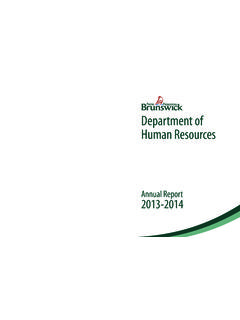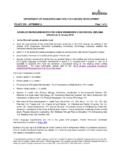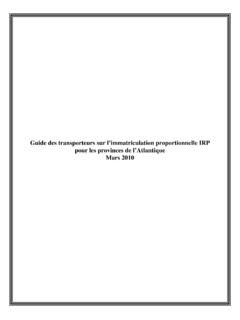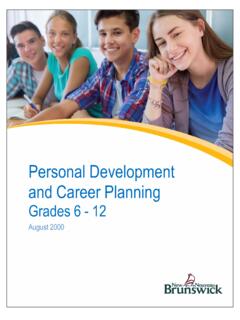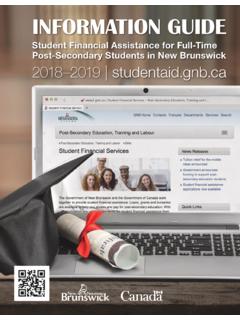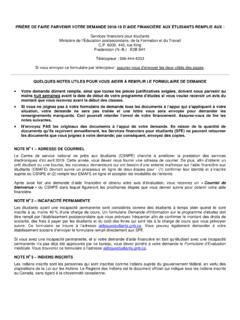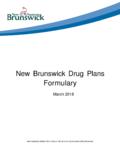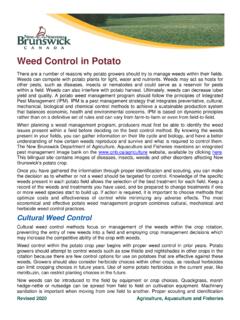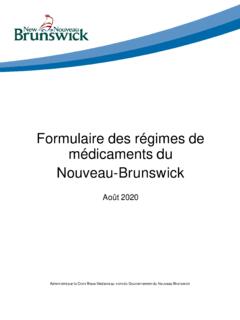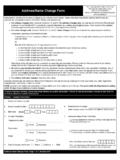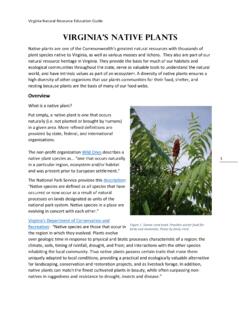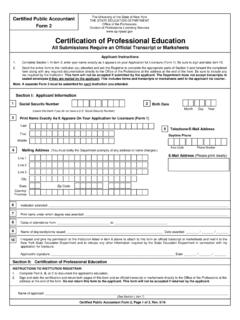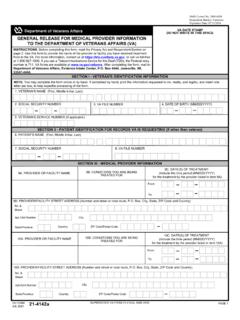Transcription of Department of Education and Early Childhood Development ...
1 Department of Education and Early Childhood Development Policy 322 Page 1 of 14 ORIGINAL SIGNED BY MINISTER Subject: Inclusive Education Effective: September 17, 2013 Revised: PURPOSE This policy establishes the requirements to ensure New Brunswick public schools are inclusive. APPLICATION This policy applies to all schools and school districts within the public Education system in New Brunswick. DEFINITIONS Accommodation: measures that allow an individual experiencing an obstacle to learning to gain access to and achieve success in regular classroom learning activities. This may involve removing barriers, ensuring accessibility, using adjustments to instructional strategies, providing one-on-one assistance or allowing some extra time to complete a task. These, and similar strategies, help each student to reach their potential, both academically and socially.
2 Age-appropriate peers: students who are approximately the same chronological age. Alternative Education program: a program for high school students (Grades 9 to 12) who require a learning opportunity in an environment that is separate from the educational program provided in the neighbourhood high school. These programs are typically compensatory or supplementary, and operationally are in distinct physical locations. Alternative Education programs may be the means for a student to complete public Education or it may be transitory, with the student returning to the neighbourhood high school. Barrier to learning: a circumstance in which the instruction provided within the common learning environment does not effectively meet the needs of the student as a learner. For example, these needs could be physical, sensorial, cognitive, socio-emotional, organizational or logistical.
3 Classroom teacher: a certified teacher employed in a New Brunswick school district who is assigned to provide instruction to a group of students in one or more subjects during the school day. Community agency: an organization that provides direct or consultative services to students and their families. Department of Education and Early Childhood Development Policy 322 Page 2 of 14 Community-based learning opportunity: additional learning opportunities within a community setting that enable students to meet prescribed learning outcomes through experiences that supplement classroom/school-based instruction. Common learning environment: an inclusive environment where instruction is designed to be delivered to students of mixed ability and of the same age in their neighbourhood school, while being responsive to their individual needs as a learner, and used for the majority of the students regular instruction hours.
4 District Education Support Services (District ESS) Team: the district level professionals, under the supervision of the Director of Education Support Services, who provide support to schools, teachers and school-based Education support services (school-based ESS) teams in meeting the needs of students. Educational assistant: paraprofessionals working in the public Education system to support teachers in meeting the instructional and personal needs of students. Education support teacher: a certified teacher working in the public Education system to support classroom teachers in developing, implementing and evaluating instructional strategies to ensure student success in learning, as well as providing direct instruction to individuals or small groups of students where appropriate. Francization: In Francophone schools, francization is a process allowing students speaking little or no French to develop their linguistic abilities, orally and in writing, in order for them to fully participate in their Francophone school, and contribute to the vitality of the Acadian and Francophone culture and community.
5 Grade retention: a process of having a student repeat a full year of instruction based on an evaluation and an individual student's progress. Inclusive Education : the pairing of philosophy and pedagogical practices that allows each student to feel respected, confident and safe so he or she can participate with peers in the common learning environment and learn and develop to his or her full potential. It is based on a system of values and beliefs centered on the best interest of the student, which promotes social cohesion, belonging, active participation in learning, a complete school experience, and positive interactions with peers and others in the school community. These values and beliefs will be shared by schools and communities. Inclusive Education is put into practice within school communities that value diversity and nurture the well-being and quality of learning of each of their members.
6 Inclusive Education is carried out through a range of public and community programs and services available to all students. Inclusive Education is the foundation for ensuring an inclusive New Brunswick society. Neighbourhood school: a local school that each student would normally be assigned to in his or her community, based on the school s catchment area. Department of Education and Early Childhood Development POLICY 322 Page 3 of 14 Parent: includes guardian, as per the Education Act. Personalized learning environment: any situation consisting of a variation of the common learning environment of a student where the student receives individualized instruction in the neighbourhood school but not in the common learning environment.
7 Personalized learning plan (PLP): a plan for a student who requires specific and individual identification of practical strategies, goals, outcomes, targets and educational supports that ensure the student experiences success in learning that is meaningful and appropriate, considering the student s individual needs. School-based Education Support Services (school-based ESS) Team: a team led by the school principal that assists classroom teachers to develop and implement instructional and/or management strategies and to coordinate support resources for students with diverse needs. In addition to school administrators, the team is made up of Education Support teachers and other staff members whose primary role is to strengthen the school s capacity to ensure student learning. The membership of the school-based ESS team will be determined by the size, level and local context of the school.
8 School personnel: as per the Education Act, school personnel means a) superintendents, Senior Education Officers and other administrative and supervisory personnel, b) school bus drivers, c) building maintenance personnel, including custodians, d) secretaries and clerks, e) teachers, f) persons other than teachers engaged to assist in the delivery of programs and services to students, g) and other persons engaged in support areas such as social services, health services, psychology and guidance. Segregated program/class: a learning environment based on one or more specific diagnoses/labels of disability or exceptionality, and typically used for a long term. Examples include life skills classes, segregated resource rooms and behaviour classes. Student: includes pupil, as per the Education Act. Student-centered learning: an approach to Education that is focused on each student s needs, abilities, interests and learning styles.
9 Universal Design for Learning (UDL): a set of principles for classroom instruction and curriculum Development that give all students equal opportunities to learn. UDL provides strategies for creating instructional goals, methods, materials, and assessments that work for everyone. This flexible approach to learning can be customized and adjusted for individual students. Variation of the common learning environment: a situation where a student is removed from the common learning environment for more than one period daily or more than 25% of the regular instructional time, whichever is greater. Department of Education and Early Childhood Development POLICY 322 Page 4 of 14 LEGAL AUTHORITY Education Act 6 ( ) The Minister may establish provincial policies and guidelines related to public Education within the scope of this Act.
10 GOALS / PRINCIPLES Inclusive public Education : Recognizes that every student can learn. Is universal the provincial curriculum is provided equitably to all students and this is done in an inclusive, common learning environment shared among age-appropriate peers in their neighbourhood school. Is individualized the educational program achieves success by focusing on the student s strengths and needs, and is based on the individual s best interest. Is requiring school personnel to be flexible and responsive to change. Is respectful of student and staff diversity in regards to their race, colour, religion, national origin, ancestry, place of origin, age, disability, marital status, real or perceived sexual orientation and/or gender identity, sex, social condition or political belief or activity. Is delivered in an accessible physical environment where all students and school personnel feel welcome, safe and valued.

